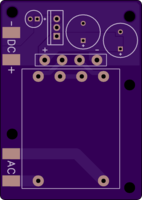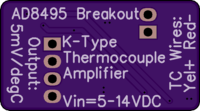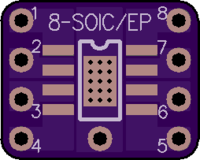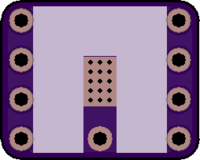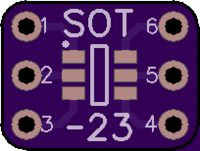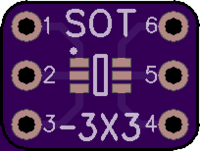OSH Park
Profile for Eric
Shared projects
Power Supply: AC Mains to Low Voltage DC
by
2
layer board of
1.63x2.30
inches
(41.43x58.34
mm).
Shared on
February 10th, 2014 19:14.
Cost: $18.70 for three.
Description:
I needed a low voltage, low current DC power supply for a mains-powered project but I was out of spare wall warts, so I whipped this together and it does the job nicely.
Holes along the edges of the board are sized for M3 x 4mm standoffs and M3 or #4-40 hardware.
The transformer footprint will accept the Triad Magnetics F16-070-C2-B (max 70mA) or F16-150-C2-B (max 150mA). I used the latter. The transformer’s secondary windings are wired in series.
The bridge rectifier footprint will accept any 4-SIP package with 0.2-inch pin spacing and max 0.050-inch pin diameter. I used a GBU-package device that I had on hand.
The TO-220 footprint will accept any of the 78XX series of fixed output linear regulators. I have tested with the ON Semiconductor NCP7812TG and measured ~40mV peak-to-peak output ripple with 100mA load. The regulator settles at ~48°C under this load with no heatsink.
The large electrolytic capacitors are 10mm diameter with 5mm pin spacing. I used two Kemet ESK108M025AH4AA 1000uF 25V caps. The small electrolytic is 5mm diameter with 2mm pin spacing. I used a Kemet ESK107M016AC3AA 100uF 16V cap.
To simplify and save cost, the board has exposed copper pads for AC input and DC output connections instead of screw terminals. Apply a little flux and wires will solder on with ease.
CAUTION: This is a mains-powered circuit. Use appropriate care with exposed high voltage and please install a properly rated fuse inline with the hot AC supply line.
AD8495 K-Type Thermocouple Amplifier
by
2
layer board of
1.15x0.64
inches
(29.11x16.13
mm).
Shared on
January 28th, 2014 06:36.
Cost: $3.60 for three.
Description:
Breakout board for the Analog Devices AD8495CRMZ K-Type Thermocouple Amplifier. This IC reads thermocouple input and scales it to 5mV (0.005V) per °C (plus a 1.25V reference offset). This output can be read by a microcontroller or a multimeter; simply subtract 1.25 from the output, then multiply by 200 to get the temperature.
U3 (Texas Instruments LP2980) is a 4.7V low dropout linear regulator which provides Vcc for U1 (Analog Devices AD8495) and U2 (Analog Devices AD8613), and also feeds a voltage divider comprising R4 and R5. 1.25V from this divider is buffered through op-amp U2 to the reference pin of U1, providing a positive offset to allow measurement of negative temperatures. The thermocouple inputs to U1 are configured with a 1kHz low pass filter for noise rejection.
This board offers a measurement range of about -25 to +400°C with maximum error of +/-2°C. Measurements are possible outside this range (roughly -200 to +900°C), with larger errors due to thermocouple nonlinearity.
An exposed ground pad is provided near the thermocouple connector for ambient temperature sensing or debugging (see AD8495 datasheet, page 13). For permanent configuration as an ambient temperature sensor, use the AD8494CRMZ instead, as its output is more linear in this configuration.
Bill of Materials:
- U1: Analog Devices AD8495CRMZ K-Type Thermocouple Amplifier (8-MSOP) – NOTE: Both Mouser and Newark have this part in stock at lower prices.
- U2: Analog Devices AD8613AUJZ-R2 Operational Amplifier (SOT-23-5)
- U3: Texas Instruments LP2980AIM5X-4.7 4.7V LDO Linear Regulator (SOT-23-5)
- C1: AVX Corp F931C106KAA 10µF 16V Tantalum Capacitor (1206)
- C2, C6: Kemet C0603C104K4RACTU 0.1µF 16V Ceramic Capacitor (0603)
- C3, C4: Taiyo Yuden TMK107BJ105KA-T 1µF 25V Ceramic Capacitor (0603)
- C5: Yageo CC0805KKX5R5BB106 10µF 6.3V Ceramic Capacitor (0805)
- R1: Stackpole RMCF0603FT1M00 1MΩ 1/10W 1% Resistor (0603)
- R2, R3: Stackpole RMCF0603FT160R 160Ω 1/10W 1% Resistor (0603)
- R4: Stackpole RMCF0603FT31K6 31.6kΩ 1/10W 1% Resistor (0603)
- R5: Stackpole RMCF0603FT11K5 11.5kΩ 1/10W 1% Resistor (0603)
- J1: On Shore Technology OSTVN02A150 2-Position Screw Terminal
- J2: On Shore Technology OSTVN04A150 4-Position Screw Terminal -or- Sullins Connector PREC004SAAN-RC 4-Position Pin Header
BOM Cost: $12.83 + Thermocouple
K-type thermocouples and in-line connectors are available on eBay for $1.25 or less, delivered. Female panel-mount connectors are available from Auber Instruments for a few dollars.
Notes:
Input voltage should be a minimum of 5VDC to a maximum of 14VDC. Current draw is less than 3mA. My board runs perfectly on a 9V battery. U3 dropout voltage is maximum 225mV, so any Vin below about 4.925V may affect accuracy. If you power the board from a 5V source, measure voltage at U3 pin 1 to ensure adequate Vin.
Do not substitute alternate parts for C1. U3 is sensitive to ESR and this cap was selected to fall within its permitted range. C1 is a polarized capacitor; ensure that the mark on this device matches the mark on the board (bar to the right).
For best accuracy, use K-type thermocouple wire (chromel/alumel) all the way to the board. If you use a panel-mount connector on an enclosure, use additional K-type wire (available here or here) from the connector to the board. It may be cheaper to buy an extra thermocouple on eBay and cut off the wire you need.
For maximum temperature calculation accuracy, measure the voltage at the pad marked “REF”. This is the reference offset voltage, which is nominally 1.254V but which may differ due to LDO, resistor and op-amp tolerances. This exact measurement should be subtracted from the output before multiplying by 200. On my board, with Vin=9V, REF measures 1.2487V
For complete information on using this board with a microcontroller and compensating for thermocouple nonlinearity, see this application note.
8-SOIC/EP Breakout Board
by
2
layer board of
0.51x0.41
inches
(12.88x10.34
mm).
Shared on
January 15th, 2014 18:06.
Cost: $1.00 for three.
Description:
Breakout board for 8-SOIC/EP package. Converts 8-SOIC/EP to breadboard-friendly 0.1-inch pitch by 0.4-inch width through-hole format.
Wide traces on all pins, suitable for use with power packages. For ICs with exposed pad, it is provided, with thermal vias to bottom side copper pour and unmasked copper on bottom side to aid soldering.
The lower-middle through-hole pad is connected to the IC exposed pad; solder a wire in this hole and jumper to appropriate IC pin.
Pins numbered on top side for quick reference and silk screen area on reverse to write part number, pin annotations, etc.
This is intended as a breadboard testing aid only. It will not provide adequate heatsinking to reach datasheet thermal limits, so don’t turn the wick up all the way!
SOT-23 & SOT-3X3 Breakout Board
by
2
layer board of
0.41x0.31
inches
(10.34x7.80
mm).
Shared on
January 15th, 2014 17:31.
UPDATED!
Cost: $0.60 for three.
Description:
Breakout board for SOT-23, SOT-323, SOT-343, SOT-353 and SOT-363 packages. Converts these 3, 4, 5 and 6-pin SMD components to breadboard-friendly 0.1-inch pitch by 0.3-inch width through-hole format. Pins numbered for quick reference.
Breadboard Power Feeder
by
2
layer board of
0.26x0.94
inches
(6.50x23.85
mm).
Shared on
January 10th, 2014 01:09.
Cost: $1.20 for three.
Description:
Small board to feed power from your bench supply to a solderless breadboard.
Install a 2x2 pin header at one end, on the bottom side. Solder wires at the other end (positive to square pad). Terminate wires with red and black banana plugs. Install this slide switch on the top side. Use a small zip-tie around the notches to provide wire strain relief.
